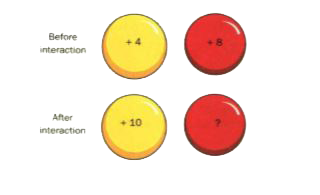Who suggested that an atom is a spherical cloud of positive charges in which lectrons were spread out?
Rutherford
Goldstein
William Crooks
J.J. Thomson
The correct Answer is:D
To answer the question "Who suggested that an atom is a spherical cloud of positive charges in which electrons were spread out?", we can follow these steps:
Step 1: Understand the Question
The question is asking about a specific scientist who proposed a model of the atom that describes it as a spherical cloud of positive charge with electrons distributed throughout.
Hint: Focus on the key terms: "spherical cloud of positive charges" and "electrons spread out."
Step 2: Analyze the Options
The options provided are:
1. Rutherford
2. Goldstein
3. William Crookes
4. J. J. Thomson
Hint: Think about what each scientist is known for in atomic theory.
Step 3: Evaluate Each Option
- Option 1: Rutherford - He is known for the nuclear model of the atom, which describes a dense nucleus surrounded by electrons. This does not match the description in the question.
- Option 2: Goldstein - He discovered protons and is not known for a model that describes the atom as a spherical cloud. This option can be eliminated.
- Option 3: William Crookes - He is known for his work with cathode rays and vacuum tubes, not for a model of the atom. This option can also be eliminated.
- Option 4: J. J. Thomson - He proposed the "Plum Pudding Model," which describes the atom as a sphere of positive charge with electrons embedded within it. This matches the description in the question.
Hint: Identify which scientist's model aligns with the description of a "spherical cloud of positive charges."
Step 4: Conclusion
Based on the analysis, the correct answer is J. J. Thomson. He suggested that an atom is a spherical cloud of positive charges in which electrons are spread out.
Final Answer: J. J. Thomson
The question is asking about a specific scientist who proposed a model of the atom that describes it as a spherical cloud of positive charge with electrons distributed throughout.
The options provided are:
1. Rutherford
2. Goldstein
3. William Crookes
4. J. J. Thomson
- Option 1: Rutherford - He is known for the nuclear model of the atom, which describes a dense nucleus surrounded by electrons. This does not match the description in the question.
- Option 2: Goldstein - He discovered protons and is not known for a model that describes the atom as a spherical cloud. This option can be eliminated.
Based on the analysis, the correct answer is J. J. Thomson. He suggested that an atom is a spherical cloud of positive charges in which electrons are spread out.
Topper's Solved these Questions
- BOOK - ICSECHAPTER - ATOMIC STRUCTURE EXERCISE - EXERCISES (True or False)5videos
ATOMIC STRUCTURE
- BOOK - ICSECHAPTER - ATOMIC STRUCTURE EXERCISE - EXERCISES (Fill in the blanks)5videos
ATOMIC STRUCTURE
- BOOK - ICSECHAPTER - ATOMIC STRUCTURE EXERCISE - Test Yourself-3 (Match the following)1videos
ATOMIC STRUCTURE
- BOOK - ICSECHAPTER - CARBON & ITS COMPOUNDSEXERCISE - OBJECTIVE TYPE QUESTIONS23videos
CARBON & ITS COMPOUNDS
Similar Questions
The model that states the atom is a sphere of positive charges and the electrons are spread out inside it. This model is called as..........
View SolutionA positive charge q is placed in a spherical cavity made in a positively charged sphere. The centres of sphere and cavity are displaced by a small distance →l. Force on charge q is :
View SolutionAn atom that loses electrons becomes a positively-charged ion called
View SolutionTotal electric flux coming out of a unit positive charge put in air is
View SolutionTwo concentric metallic spherical shells are given positive charges . Then
View SolutionPositively charged hydrogen atom is known as
View SolutionFigure D shows two spheres that initially have +4 and +8 positive charge. After an interaction (which could simply be that they touch each other), the yellow sphere has +10 positive charge, and the red sphere has an unknown quantity of charge. Use the law of conservation of charge to find the final charge on the red sphere.
 View Solution
View Solution
In the given structure at how many atoms the positive charge will be delocalised through resonance (Exclude the carbon at which positive charge is present in the given structure)View SolutionWhat is the positively-charged core in the centre of an atom called?
View SolutionIn the Thomson's model of atom, which of the following statement are correct ?
(i) The mass of the atom is assumed to be uniformaly distributed over the atom.
(ii) The positive charge is assumed to be uniformaly distributed over the atom.
(iii) The electrons are uniformaly distributed in the positively charged sphere.
(iv) The electrons attract each other to stabilise tha atom.View Solution
